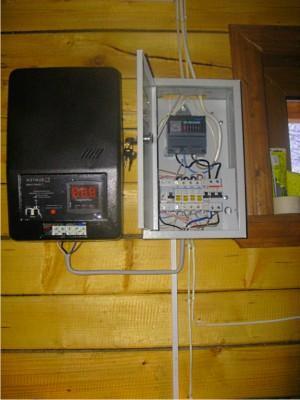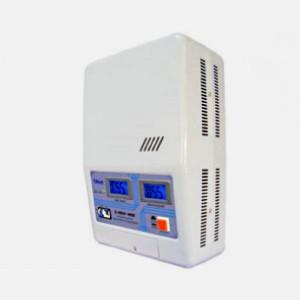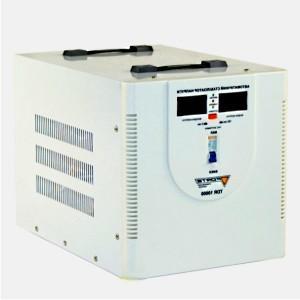Review and selection of voltage stabilizers for summer cottages and houses
At dachas or in country houses, problems with voltage drops in the network often arise. In this case, there is only one solution - a voltage stabilizer for the home.
Classification of stabilizers. Which voltage regulator is better?

High or low voltage can cause failure of most electrical appliances. Voltage surges occur due to the centralized regional setting of the average voltage along the entire length of the transmission line.
Voltage 220V can be at the midpoint of the line. Depending on the distance from this point the house or summer cottage is located, some voltage fluctuations are possible. Accordingly, houses located closer to the substation will most often have increased voltage in the network. Houses that are farther from the substation suffer from voltage drops.
To protect the house and electrical equipment from power surges, there are special devices - voltage stabilizers for giving.
The essence of the stabilizer is to control the input voltage. It switches the turns of the transformer, equalizes the current, and applies the corrected voltage to the output.
The most common types of stabilizers are:
- Servo-driven;
- Relay;
- Electronic or thyristor.
Servo voltage regulator

These stabilizers change a certain number of turns of the transformer, thereby regulating the output voltage. The slider of the servo motor, moving along the turns of the transformer, regulates the input voltage mechanically. Devices of this type are not reliable in operation.
- Advantages: low price;
- Disadvantages: many mechanical components that often fail;
- The most frequent breakdown: deviations in the operation of the servo-drive mechanism, sticking of the angle-graphite unit.
Relay voltage regulator

It has a switching mechanism that switches the transformer windings and consists of a block of several power relays.
- Advantages: occupies an average price place in the stabilizer market and has a smaller number of mechanical assemblies;
- Disadvantages: limited service life (from 1.5 to 2 years, depending on the frequency of power surges in the network);
- Common breakdown: sticking relay contacts.
Electronic (thyristor) voltage stabilizers

The main mechanism of electronic stabilizers are electronic circuits, semistors, thyristor switches, capacitors. These are the most reliable types of stabilizers. They have a long service life and will be the best option when choosing a voltage stabilizer for your home.
- Advantages: speed (response of input voltage triggering up to 20 ms), quiet operation (an important component in a residential area), uninterrupted operation for a long period, does not require maintenance, user-friendly interface.
- Disadvantages: Cost (about twice as expensive as a relay regulator, and almost three times as expensive for a servo).
Which voltage regulator is better?
The best for a summer cottage or at home will be an electronic stabilizer. It can be connected immediately after the meter to ensure the safety of electrical appliances throughout the house.
How to choose a voltage stabilizer for your home
To select a suitable voltage stabilizer model for a house or summer cottage, it is necessary to determine the number of phases of the supply input voltage.
With three-phase input voltage, a three-phase regulator is therefore required.Some owners install three single-phase stabilizers and connect them together.
Most summer cottages have one phase. For such networks, a single-phase stabilizer is required. An electronic (thyristor or seven-story) stabilizer is the best and most reliable type of single-phase voltage correctors.
One of the important indicators when choosing a stabilizer is its power, since some models have the negative property of losing power when the voltage drops in the network.
Well-known manufacturers of thyristor stabilizers Lider PS (NPP Inteps Company), as well as seven-story electronic stabilizers Volter SMPTO (ChNPP Electromir Company) have a wide range of products in stock.
Stabilizers have superior power and performance characteristics. All models of the companies have excellent climatic performance (frost resistance and moisture resistance in the range of -40 C + 40 C), as well as impregnation with special compounds of all units and boards of the inner filling. Such properties eliminate the occurrence of a short circuit when condensation appears inside the stabilizer.
If the stabilizer does not have a similar moisture-frost-resistant treatment, it is not recommended to operate it at subzero temperatures.
Stabilizers Lider PS

Designed to stabilize the voltage in the event of fluctuations in the alternating current network, power supply and protection of various household electrical appliances. The power devices have a range from 100 VA to 30 thousand VA (single-phase network) and 2.7 - 90 kVA (three-phase network). Designed for round-the-clock functional protection of a home network against voltage surges in the range of 125-275V (model W-30), 110-320V (model W-50).
The simplest ones are Lider PS W-series stabilizers. Their electronic filling ensures stabilization accuracy (the error can be no more than 4.5%), and the response speed of control signals is 250 V / s. The stabilizer is controlled by an electronic microprocessor (controller).
Stabilizers Volter SMPTO
 Designed for voltage correction in internal networks, where deviations from rated voltages are about 5%. The manufacturer offers a wide range of products that have different stabilization accuracy of 0.7 - 10%, as well as correction of the lowest input voltage from 85V. The control of the filling and stabilizer systems is carried out by an intelligent system, the operation of which is regulated by the central processor.
Designed for voltage correction in internal networks, where deviations from rated voltages are about 5%. The manufacturer offers a wide range of products that have different stabilization accuracy of 0.7 - 10%, as well as correction of the lowest input voltage from 85V. The control of the filling and stabilizer systems is carried out by an intelligent system, the operation of which is regulated by the central processor.
According to the review of voltage stabilizers for home, Volter SMPTO and Lider PS are the best options. They are silent, compact and reliable assistants in solving problems with power surges in suburban or home networks.
Thanks for the interesting article and detailed recommendations on choosing a voltage stabilizer for a summer residence. Recently in my country house, due to power surges, a refrigerator broke down (not very new, but also a pity). Now, here, I want to buy a reliable stabilizer, since such problems with voltage drops happen often (I don't know why). I want to buy an electric stabilizer. The article suggests, as the best option, Volter SMPTO or Lider PS. Maybe someone uses such stabilizers and knows what they are in work? Is it worth buying them?
Buying a voltage stabilizer in a store, we hope that it will last a long time and will reliably protect the house from problems with electricity. However, in reality, the stabilizer often does not withstand even one year of operation.
A stabilizer is NOT needed for a sauna at all.
In general, I agree that "Volter SNPTO and Lider PS are the best option." However, it is also important what power the stabilizer needs and what is the minimum voltage at the input.If you need 10 kW and the voltage does not fall below 140 volts, then I would put the Rostov Skat ST-12345, and if it falls below 120 volts, then the Donetsk Ukrtechnology INFINITI-12000
For the second year, the Ruself voltage stabilizer for 12KVA has been working at home, before this stabilizer there were resants, they had to be changed every year, since the repair under warranty 5 times during the year, then the repair is paid and expensive.
Considering my many years of experience in the field of electrical engineering, I want to say that the Etalon 7 IGBT stabilizers have proven themselves very well. Their functions allow you to instantly stabilize the voltage in the network, in just 40 microseconds, they do not blink light, but on the contrary eliminate the blinking of lamps even during welding, and their input voltage range is wide: from 105 to 330 Volts, I'm not talking about that their service life is very durable, they give a guarantee for 10 years.
I don’t trust our equipment yet and in order not to run around the repair shops I bought an Italian Orion stabilizer for my house. For the fourth year I have been living without worries. Money is not small, but you have to pay for comfort
Take the stab Energy SNVT-8000 or SNVT-10000, you will not go wrong. For a summer residence, the very thing is simple and reliable. I took SNVT-10000 myself with a margin. I don’t even remember the energy jumps now, the third year has passed. It works and works - I just needed to take it, put it on and forget. The service life according to the documents, if I remember correctly, is 15 years.
I have a question about choosing a stabilizer. I have a car shop in the basement of which two electric boilers hang, both with different voltages of 9 kW and 12 kW, plus they also install a new cash register, a computer and an electric kettle. A friend advised me to buy stabilizers from a domestic manufacturer. Do you think these are good voltage regulators? And is it better to buy three-phase or three single-phase?
For Tatiana, I recommend starting from the dynamics of tension. If you have 170 volts at the input, a 9 kW boiler needs a 12 kW stabilizer. A 12 kW boiler at this voltage (170 V) will require a 15.6 kW stabilizer. Don't be fooled by Chinese manufacturers. look at the input automatic stabilizer and not at the bright sticker on the front of the device.
Introductory automatic machine 40 A - 9 kW stabilizer pr Uinput = 220 V,
50 A- 11 kW stabilizer pr Uinput = 220 V,
63 A -14 kW stabilizer pr Uinput = 220 V,
80 A - 18 kW stabilizer pr Uinput = 220 V,
100 A - 22 kW stabilizer with Uinput = 220 V.
The power of the stabilizer decreases in proportion to the voltage drop. The formula is simple
P (stabilizer) = (Uin / 220) * P (nominal stabilizer).
For the dacha I bought an 8 kVA model of the SNVT stabilizer produced by Energia. The thing is quite decent, it works without interruptions and any other problems. And what is important to us is that the TV set does not burn out, otherwise we will die out of boredom, the rest is nonsense
I took myself a simple energy stabilizer, I don't remember the marking, I only know that it is 5kVA. I took it for the garage and sold it with it. As for the efficiency, the stub has never let me down.
In our village, the voltage is stably low, the gas boiler is constantly deaf, and the pump did not even turn on. I got a relay stabilizer Energy ARS 1500 and now I'm getting high)) The model is compact, you can hang it on the wall, the voltage levels out in a wide range - from 120 to 276 V.
For several years I have been using the Energia ASN-5000 relay at my dacha. Since the voltage is much lower than normal and is constantly jumping, it is almost impossible to use any household electrical appliance without it. The stabilizer is quite compact and inexpensive.
I live in an apartment in M.O. When there is a thunderstorm in the summer, my tension rises.On one of these days, the TV ordered to live long. I paid about 13,000 rubles for repairs. After that I bought a Relay Calm R400. Funny in a thunderstorm, reels click. It was relay, step. Exactly one year worked and died. Now on TV and on the music center, I bought SNPTO Volter 2000. Bribed a 5-year warranty. There are 5 sockets on the back. And nothing clicks ... ...